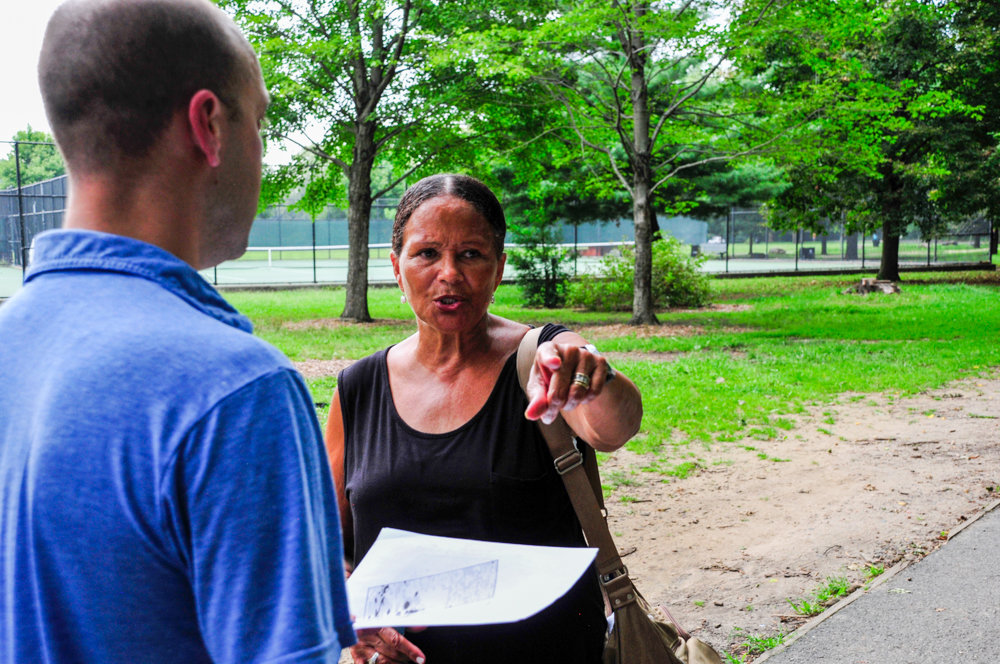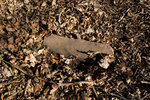Radar confirms Vannie location of Colonial slave burial ground
In a thicket not far from the Van Cortlandt House Museum stands a tall and elegant cypress tree.
“That’s a rare tree for this area,” said park volunteer Michele March. “It’s a symbol of eternal life.”
Cypress has traditionally been planted in cemeteries, marking them as burial grounds long after their locations are forgotten. The evergreen stands vigil over a roughly half-acre near the Putnam Trail local historians are now certain is the resting place of enslaved Africans buried there more than 200 years ago.
A team of soil scientists with the U.S. Department of Agriculture used ground-penetrating radar to scan four sample areas of the park in January. The results found telltale characteristics of a cemetery — long rumored to be the forgotten resting place of people enslaved by the area’s Colonial settlers like the Van Cortlandt and Tippett families.
A well-documented history
Long before it was a park, Vannie was an estate bought by Jacobus Van Cortlandt — twice mayor of New York City — in 1691. March leads tours examining the park’s features through the lens of the enslaved people forced to tame the relative wilderness that became the Bronx.
“Their hands shaped this land,” she said.
Historical evidence shows slaves dammed Tibbetts Brook to create Van Cortlandt Lake, March said. They built the nearby Old Albany Post Road. They cleared fields and grew the corn and ground it at the estate’s gristmill. The stately Van Cortlandt mansion was built, stone by stone, by people forced into hard labor.
March feels a deep and personal connection to that history.
“I am, myself, only three generations away from slavery,” she said.
Since the 1980s, a small number of headstones lay behind Van Cortlandt House. They are worn by time and weather, but still bear names and dates.
“The headstones were kind of piled up with a bunch of trash over here,” Kingsbridge Historical Society President Nick Dembowski said, pointing over the house’s wrought iron perimeter fence. “These are headstones from 1790, and they’re among the last relics of Colonial Kingsbridge.”
Where did they come from? It got Dembowski thinking.
He’d previously researched the 18th century African population in the area. Through snippets of surviving records — wills, plantation inventories, runaway slave notices, census counts — Dembowski found evidence that the area around Van Cortlandt Park contained the largest concentration of slaves in the area. Dembowski believes the Van Cortlandts owned up to 20 slaves themselves at one point.
These records reveal the extent Colonials treated enslaved people as property to be sold and counted along with the estate’s other assets — all while documenting humanizing details like their family members and their individual skill sets.
Dembowski found documents showing there were two cemeteries in Kingsbridge — one for people of European decent, and the other for slaves. Historians knew the location of the former, but not the latter.
News from a century ago
In May 2018, after some digging through old documents and local lore, Dembowski found a short blurb from an 1875 news article. It stated that work crews tasked with building a railway line through the park uncovered human bones.
“These are supposed to be remains of slaves once owned by the Van Cortlandt family,” the story reads. It also highlighted Yonkers resident Caleb Van Tassel, who was 84 when the story was published, had made a coffin for a slave who was buried near the Van Cortlandt mansion. Some 50 years earlier.
The piece was sparse on details, but it finally gave Dembowski a name and documented history upon which to hang his theory. He and the park’s administration had already begun talking about how to find more supporting evidence when another development — paving the Putnam Trail — increased the priority to explore what was underground.
Officials with the state’s Historic Preservation Office urged city park’s officials to move quickly. Enter the USDA scientists to perform underground testing.
“If news of this burial ground had broken at any other time, it may have been really hard to get a ground-penetrating radar,” Dembowski said. “But the fact that we said, ‘Hey, you may be paving over bodies here, are you sure you want to do that?’ That really got the ball rolling.”
Scans of four sections near and beneath Putnam Trail showed multiple pockets of anomalous material arranged in a linear formation.
It was the last piece of evidence Dembowski needed to confirm this was the long-suspected burial ground.
“Until this, (the burial ground) was completely off the map, off people’s radar,” Dembowski said. “What makes it so amazing is that it’s all coming out now. It was in the news 100 years ago, and no one knew anything more about it.”
Remembering those buried
Since the report confirmed the cemetery’s existence, March has dedicated her time to researching the park’s history and advocating some permanent tribute to the people buried there. Dembowski said the parks department seems genuinely interested in placing something at the site to educate the public about the burial ground and the lives of enslaved people laid to rest there.
That could include a commemoration of the site with signage, according to parks department spokesman Dan Kastanis.
“The City of New York has many buildings and parks that stand on former burial grounds,” he told The Riverdale Press. “To our knowledge, more than 50 parks encompass former burial plots, including some of our most notable parks like Washington Square Park, Union Square and Bryant Park.”
As soon as the Kingsbridge Historical Society provides direction and wording for signage, Kastanis added, the parks department will collaborate with them to make a permanent marker a reality.
“I think now that the parks are aware that it’s here, its significance and historic value, it now becomes the goal of what to do with it,” March said. “We want to protect it, preserve it, and present the history to the public — the history of the enslaved Africans that were part of and belonging to one of the premier families in New York City.”
Who is believed to be buried in the park is unknown. But no matter who they were, they are a direct connection to African American history, March said. It’s another thread in the fabric of their story — one of heartbreak, pain, suffering — but ultimately triumph.
“They’re laying there, a lot of secrets, a lot of stories to tell,” March said. “Their bones — whatever is left of them — have the DNA fingerprint of where they came from, how they were treated once they got here, their age, their health condition, maybe possibly the kind of work that they did.”



















